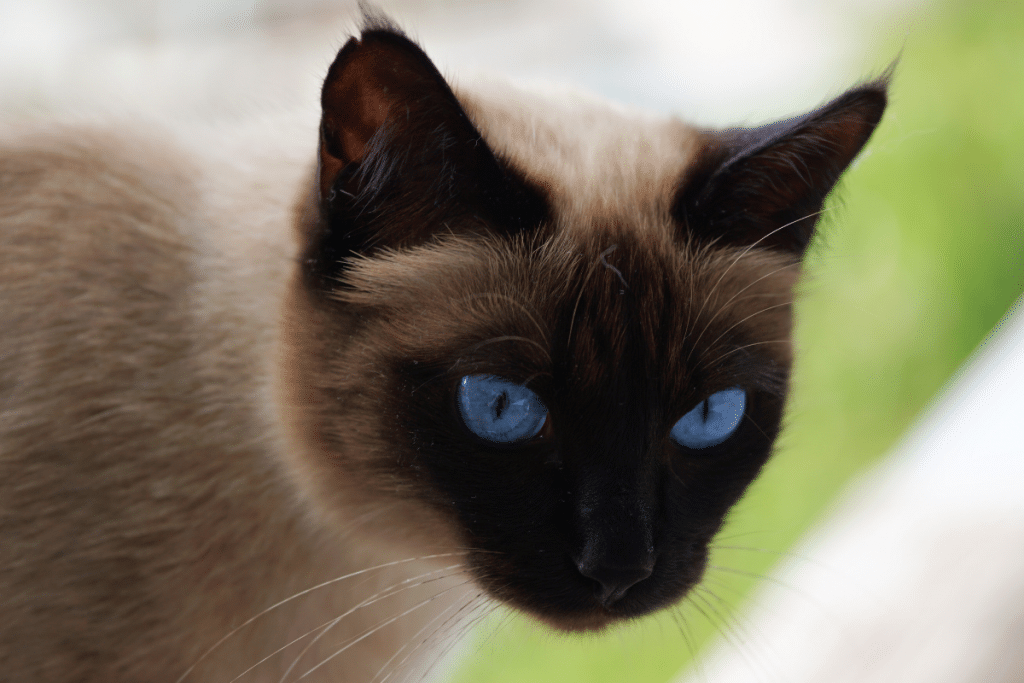Did you know that Siamese cats usually spend 50 percent of their time grooming themselves when they are awake? Of course, we all know that cats sleep a lot. It is almost their favorite pastime. They cannot live without their naps. However, grooming is also extremely important to them. This is how they keep their coat smell-free and clean. Moreover, when hunting, if their coats are odor-free, it is almost like they are invisible to their enemies.
However, there are some common Siamese cat skin problems that you may witness every now and then. You could find that your cat has scabby skin or its coat is soar or lacks the usual luster – in this case, you must determine the underlying problem. If you cannot, take it to the vet. Skin disease is an indicator that something is wrong. It may even point to a medical problem.
Skin Disease
If you find that your cat’s fur is looking starry and dull, it is a sign that it has not been grooming itself properly. If the cat’s fur is matted, it may be a sign that it is not feeling well today and does not feel like washing up.
Some factors that could interfere with her hygiene and lead to greasy, dry, or flaky skin include:
- Obesity: The cat has become fat and developed too much girth, which is reducing its access around its body.
- Tooth Ache: When a cat is having oral hygiene issues, it will find grooming itself very painful.
- Sickness: If the cat does not feel well or is nauseous, it will not want to wash up.
- Arthritis: Soreness and stiffness of muscles can make moving a difficult task for a cat.
- Anxiety: If a cat is stressed or scared, it may over-groom itself. This is a coping mechanism it uses to comfort itself. This can lead to hair loss and skin sores, causing the cat’s skin to look patchy.
The best way to prevent these problems is by dealing with the underlying cause. This way, your cat will start grooming itself again.
Common Siamese Cat Skin Problems and How to Prevent Them
If your cat’s skin does not look sleek and glossy, there is a problem. Here are some common skin diseases that your cat may be facing:
- Scales
- Dandruff
- Sores
- Ulcers
- Scabs
- Redness
- Itchiness
- Loss of Hair
- Greasiness
All the above are common Siamese cat skin problems. Keeping an eye on the symptoms is very important to avoid further complications. The signs do not always confirm the disease; therefore, taking your cat to the vet and finding out the exact problem is a must.
The vet will start examining your cat for the following conditions and diseases:
1. Parasitic Skin Disease
The vet will always begin the examination by checking your cat for skin parasites. These tiny living creatures result in a lot of itchiness, making the cat uncomfortable. They are found on the surface of skin cells, sucking the cat’s blood. Over time, this leads to sores and scabs.
One of the most common examples of Parasitic Skin Disease is flea allergic dermatitis. You will know if your cat is suffering from this if you notice flea dirt along with the appearance of little scabs on the skin. This illness can seem confusing. However, to break it down, because of flea saliva, the cat’s immune system gets messed up and results in the appearance of many tiny scabs all over the skin. A single flea bite raises an army of tiny scabs on the cat’s skin.
Some of the most common external parasites are:
• Lice
• Fleas
• Cheyletiella (dandruff mites)
• Demodex
Harvest mites
If your cat has skin parasites, you need to get rid of them as soon as possible. Otherwise, they can start to seriously affect your cat’s health. Moreover, these fleas can also latch themselves on other pets in your house. Once they are gone, you will notice the change in your cat’s skin and behavior yourself.
2. Allergic Skin Disease
Generally, cats are no different than human beings. They, too, are allergic to certain things and cannot stand to be in the same space as them. They may be allergic to a certain kind of smell, dust, or even some kind of food.
As mentioned before, skin parasites can also trigger allergic reactions. Therefore, always check if your cat has parasites if it is facing an allergic reaction. This is important before examining the cat further to avoid a misdiagnosis.
If your cat has a food allergy, you will notice its skin getting sore. In order to resolve that, you will have to change its food, and the soreness will go away itself.
In some cases, the allergy is not recognized. This is a problem on its own. However, in these cases, the cat is usually given drugs that help with the itchiness by numbing its immune system. This may be a temporary solution.
3. Skin Infections
With animals, it is a difficult task to keep them safe and ensure that no harm is done to their skin. However, any damage caused to the skin will let bacteria in and lead to an infection.
When you see something looking like an inflamed sore which might release a yellow discharge, it is definitely a bacterial infection. You will have to immediately take your cat to the vet and get it treated. If you give it a nice saltwater bath, it may feel soothing for a while, but a proper medication treatment is essential.
The bad news is that skin infections are not limited to bacteria only. There are many other skin infections like ringworms. They spread really fast and can be detected through the bald patches on the cat’s skin, which expand with time and become more and more painful. You also have to be careful while checking your cat for fungal infection as it can spread and infect you as well. The treatment for fungal infection is generally some antifungal medicine and shampoo for the cat.
4. Skin Cancer in Cats
Skin cancer is an alarming thing on its own. In cats, it is seen very rarely, but when it is seen, it can be extremely tough.
One of the most common skin cancers is squamous cell carcinoma. This cancer has an impact on the color of the cat’s skin, and there is a lack of pigment seen on the cats’ ears, lips, and nose. You will notice some white cats that have pink gums and eyelids- this is a deficiency of melanin. It is a protective pigment, and because of its shortage, skin cancer is likely to occur.
White cats should be taken extra care of. Avoid unnecessary sun exposure, or else the skin will get damaged, resulting in skin cancer. If you have a Siamese cat, always keep an eye on any redness on its skin. We also find pet-safe sunscreen nowadays- you can use that if your cat loves spending time outdoors in the sun.
Vets suggest surgeries for early-stage cancer which eliminates the signs of the cancer spreading and developing into an aggressive form.
Treating Cat Acne
Just as humans get acne, cats can suffer from it too. It usually shows up around the mouth or chin area but can be found anywhere on the cat’s body. They may look similar to the human version of blackheads and whiteheads.
In severe cases, your cat may start to lose hair, and its skin may get red. There may even be some bleeding scabs or nodules that develop over time. If the cat licks or scratches its acne, it will lead to a bacterial infection that can spread very fast.
Here are some tips to deal with cat acne:
1. Warm Compress
A warm compress or towel rinsed in warm water can help reduce the swelling in the acne area. This may also help relieve any pain or itching the cat is facing.
It is important to soothe the cat’s wound; otherwise, it will keep touching it with its nails. If the pimple is itching, the cat will scratch it without any thought of a potential skin infection developing. It is important that, as its owner, you keep an eye on it.
2. Medicated Shampoos or Wipes
You will find many over-the-counter wipes and shampoos available at your local vet clinic. These are an alternative to antibacterial medication that is usually taken orally for cat acne.
Your vet may also ask you to use a medicated shampoo for a certain period of time so that the breakout can disappear.
3. Antibacterial Medicines
If the skin infection is serious, the vet will treat it with an antiseptic ointment that is safe to use on the cat’s skin. Moreover, they might also clip some hair around the cat’s chin to avoid irritation.
Don’t worry- these are common Siamese skin problems that everyone deals with once in a while. However, as long as you know how to treat and prevent them, you are good to go!



